Total livestock inventory in the Province reached 26,177 heads as of 1 January 2021. This figure posted a decrease of 2.12 percent compared with the inventory of 26,743 heads during the same period of 2020. This can be attributed to the decrease in the inventory of livestock particularly of hogs and goats.
By animal type, hogs accounted for the biggest share (48.14 percent) in the total livestock inventory of the Province as of 1 January 2021. This was followed by Goat with 24.47 percent share, Carabao with 19.20 percent share, and Cattle with 8.18 percent share.
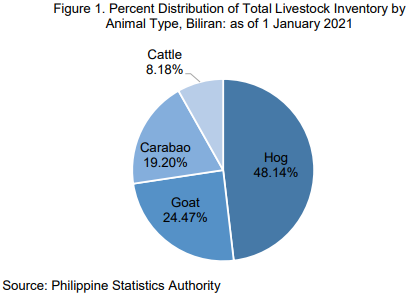
By farm type, there were more animals raised in backyard farms (25,259 heads) than in commercial farms (1,185 heads) as of 1 January 2021. Livestock raised in backyard farms accounted for 95.52 percent while those in commercial farms shared 4.48 percent.
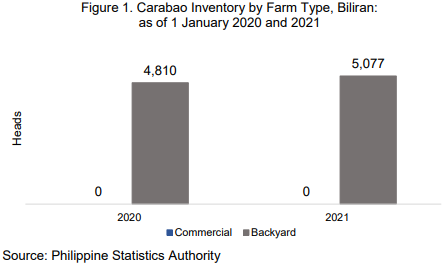
CARABAO SITUATIONER
As of 1 January 2021, inventory of carabao in the Province totaled to 5,077 heads. This resulted to a 5.55 percent increase in its inventory from 4,810 heads as of 1 January 2020.
By farm type, all 5,077 carabao heads as of 1 January 2021 were raised in backyard farms. There was no reported inventory of carabaos raised in commercial farms in both reference periods.
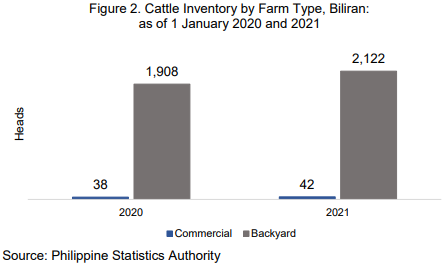
CATTLE SITUATIONER
By farm type, cattle in backyard farms comprised the largest share or 98.06 percent of the total provincial cattle inventory as of 1 January 2021 while those in commercial farms shared only 1.94 percent.
Backyard and commercial farms reported increases of 11.22 percent and 10.53 percent, respectively.
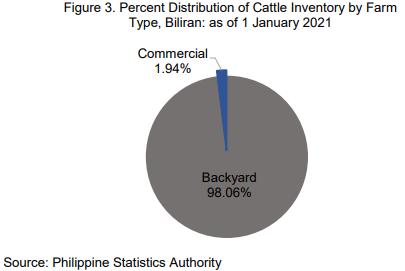
GOAT SITUATIONER
Provincial inventory of goats was recorded at 6,472 heads as of 1 January 2021 which is lower by 24.47 percent compared with the 6,935 heads recorded during the same period of 2020. This can be traced to decreases recorded in goats raised in both backyard and commercial farms.
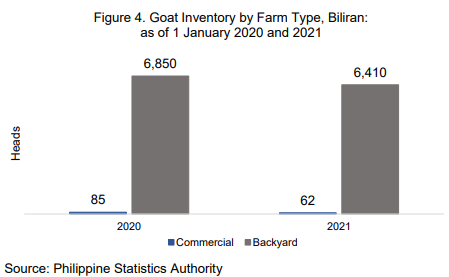
By farm type, almost all (99.04 percent) of the total provincial goat inventory as of 1 January 2021 were from backyard farms. Its inventory dropped by 6.42 percent from 6,850 heads to 6,410 heads.
Meanwhile, goat in commercial farms comprised 0.96 percent. Its inventory also declined by 27.06 percent from 85 heads to 62 heads.
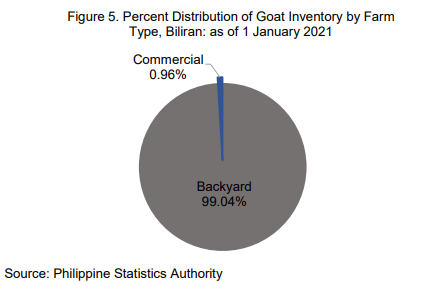
HOG SITUATIONER
The Province recorded a total hog inventory of 12,731 heads as of 1 January 2021. This figure posted a decline of 48.14 percent from its inventory of 13,052 heads during the same period of 2020.
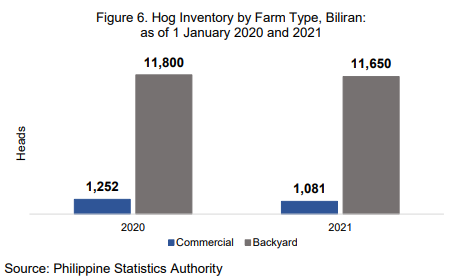
By farm type, hogs raised in backyard farms accounted for 91.51 percent of the total hog inventory in the province as of 1 January 2021. Moreover, its inventory was recorded at 11,650 heads, lower by 1.27 percent than its inventory of 11,800 heads during the same period of 2020.
Hogs raised in commercial farms comprised the remaining 8.49 percent. It posted a decrease of 13.82 percent from 1,375 heads as of 1 January 2020 to 1,185 heads as of 1 January 2021.
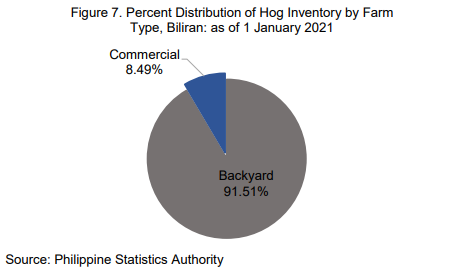
CHICKEN SITUATIONER
Total chicken population in the Province stood at 193,990 birds as of 1 January 2021, posting an increase of 12.97 percent from its inventory of 171,724 birds during the same period of 2020. This resulted from the increase recorded in all chicken types.
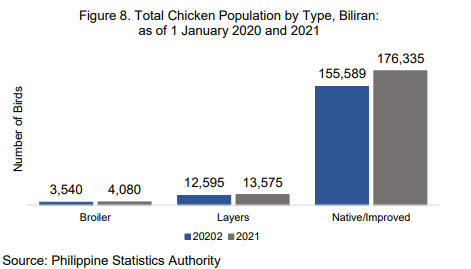
Inventory of broiler chicken recorded the biggest increment by 15.25 percent from 3,540 birds to 4,080 birds. This was followed by the native/improved chicken with a recorded increment of 13.33 percent, from 155,589 birds to 176,335 birds and by layers chicken by 7.78 percent, from 12,595 birds to 13,575 birds.
By type, native/improved chicken comprised the majority (90.90 percent) of the total provincial chicken population as of 1 January 2021. Meanwhile, layers chicken and broiler chickens shared 7.00 percent and 2.10 percent, respectively.
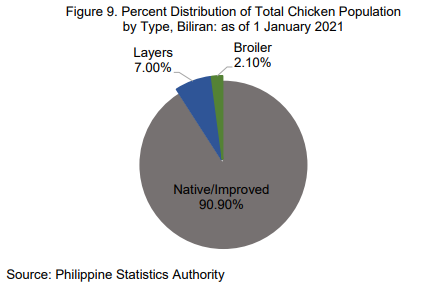
DUCK SITUATIONER
Decrease by 4.44 percent was noted in the inventory of ducks from 4,909 birds as of 1 January 2020 to 4,691 birds as of 1 January 2021.
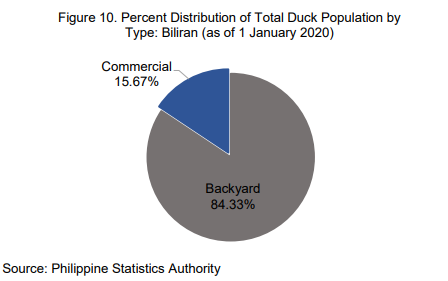
By farm type, ducks in backyard farms accounted for 84.33 percent of the total provincial duck inventory as of 1 January 2021. Ducks in commercial farms, on the other hand, comprised 15.67 percent.
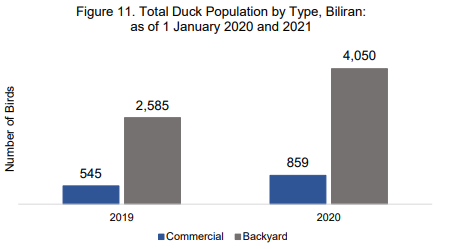
Both farms showed decreasing inventory as of 1 January 2020. Inventory of ducks in backyard farms decreased by 2.32 percent while those in commercial farms decreased by 14.44 percent.

EXPLANATORY NOTES
The data for this special release were collected by the Philippine Statistics Authority (PSA) through the two (2) major surveys, namely:
1. The Backyard Livestock and Poultry Survey (BLPS) which covers one (1) of the four (4) replicate samples of the Palay and Corn Production Survey (PCPS); and
2. The Commercial Livestock and Poultry Survey (CLPS). A livestock farm is considered commercial when its operation satisfies at least one of the following conditions: (a) at least 21 heads of adults and zero young, (b) at least 41 heads of young animals, or (c) at least 10 heads of adults and 22 heads of young animals. A poultry farm is considered commercial when its operation satisfies at least one of the following conditions: (a) at least 500 layers, (b) at least 1,000 broilers, or (c) 100 layers and 100 broilers, if raised in combination.
Data collection for swine and chicken is done quarterly. BLPS is conducted during the first seven (7) days of the first month after the reference quarter while CLPS is conducted during the last eight (8) days of the last month of the reference quarter.
Another survey that supplements the data requirements of the Livestock and Poultry sector is the Survey of Slaughterhouses and Poultry Dressing Plants. This survey is done monthly and utilizes administrative data from accredited slaughterhouses and poultry dressing plants including the Locally Registered Meat Establishments (LRMEs).
SGD. RENAVIL V. CUEVA
Chief Statistical Specialist

